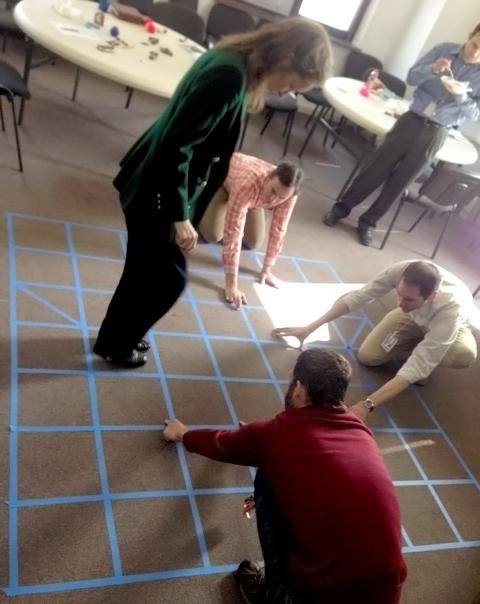Lessons from the Maze
During a recent trip to a USAID Mission to support their development of a Learning Plan, the USAID/LEARN team had the opportunity to test a new (to us) experiential learning activity. Taken from Teampedia, the exercise was called “The Maze” and was intended to explore the topics of communication, collaboration, and team strategy—perfect for a short-term assignment focused on collaborating, learning, and adapting (CLA).
In this exercise, participants took turns trying to find their way through a masking tape maze on the floor of the mission’s training room. Our maze was a 7x7 grid and the hidden path to get across it was only 12 small steps, but the group quickly found that it was not as easy as it looked.
The object of the activity was for the whole group to move from the marked entrance square to the marked maze exit, with each person taking turns and the facilitator letting them know if they had successfully stayed on the path. Once a participant made an incorrect move, the next person in line got a chance, beginning from the entrance square. We played it out in two rounds with slightly different rules for each.
Participants in the first round were not allowed to talk and could not use any materials to mark the correct path. Quickly realizing that they had to find a way to mark and communicate the right path, many of the participants immediately dropped to the ground and put their hands on the correct squares, guiding their colleagues with emphatic gestures.

In the second round, a new path was chosen and both talking and breadcrumbs were fair game. Lots of discussion of strategy ensued as to whether calling out cardinal directions would be easiest (and if so, which way was north) and what path markers they would use. Colored M&Ms were chosen for their convenience, but prompted a subsequent discussion on what the colors meant. Although we did not keep track of the number of attempts it took for the team to cross the maze (a personal lesson learned for next time), everyone agreed that it went more quickly the second time around, but not substantially so.
As in most exercises like these, the true learning emerged in the discussion afterwards as the participants compared experiences of the two rounds and discussed the applicability to mission’s work. Here are the main reflection points that they identified:
Communication—The team agreed that their non-verbal communication in round one had been very effective and admitted that speaking did not actually help them. Rather, it led them to over-complicate their interactions. Lesson: Communication is critical, but does not need to be complicated. If a process is working, do not abandon it to a new method unless there is a good reason to do so.
Assumptions—When giving verbal cues using the cardinal directions, it was immediately clear that some participants did not know which way was north and selected a direction at random. Once someone alerted everyone to true north, they were all back on the same page. Lesson: It is important to clarify assumptions and establish guiding facts before beginning an activity.
Institutional Memory—At one point during round one, when the team was using their hands to mark the path, one of the participants accidentally lifted his hands and could not remember where they had been. It was a big setback for the team and reminded everyone of what can happen when mission staff rotate to a new post. Lesson: Find a way to capture critical tacit knowledge.
Leapfrogging—Along with the discussion about institutional memory, one participant noted the potential for leapfrogging to speed up the process if they had been allowed to start from where the last person left off, rather than starting back at the beginning every time. Lesson: We are rarely starting from scratch in development work. It is important to leverage and build upon the work done before (knowledge about which should come from the mission’s institutional memory bank).
Failing Fast—Once the participants got going, they moved through the line quickly, queuing up ready to jump in and take their turn. They encouraged one another not to overthink their next step, but to try a path and if it did not work out, the next person would have one more data point to guide their decision. Lesson: We cannot be so afraid of failure that we do not move; we just have to quickly learn from our mistakes and let them inform our next actions. This can only happen in a supportive environment.
Goals—When asked if it had helped at all to have the exit square marked, the participants had mixed feelings. On one hand, it saved them one step and gave them a very general idea of direction. On the other hand, since the path could (and did) move forwards, horizontally, diagonally, and even backwards, the connection between each individual step and the exit was much less clear. Lesson: USAID operates in complex environments often requiring nonlinear interventions. There are many ways to achieve targets, but we must be flexible and adapt to the context in order to be effective.
This experiential exercise helped to demonstrate the concepts of learning from our work, the benefits of adaptive management, and the value of collaborating as a group. Starting with the Maze set the tone for more practical discussions on creating a learning plan for the mission.
If you try The Maze out for yourself, please let us know what lessons you take away. Share them in the comments below.



